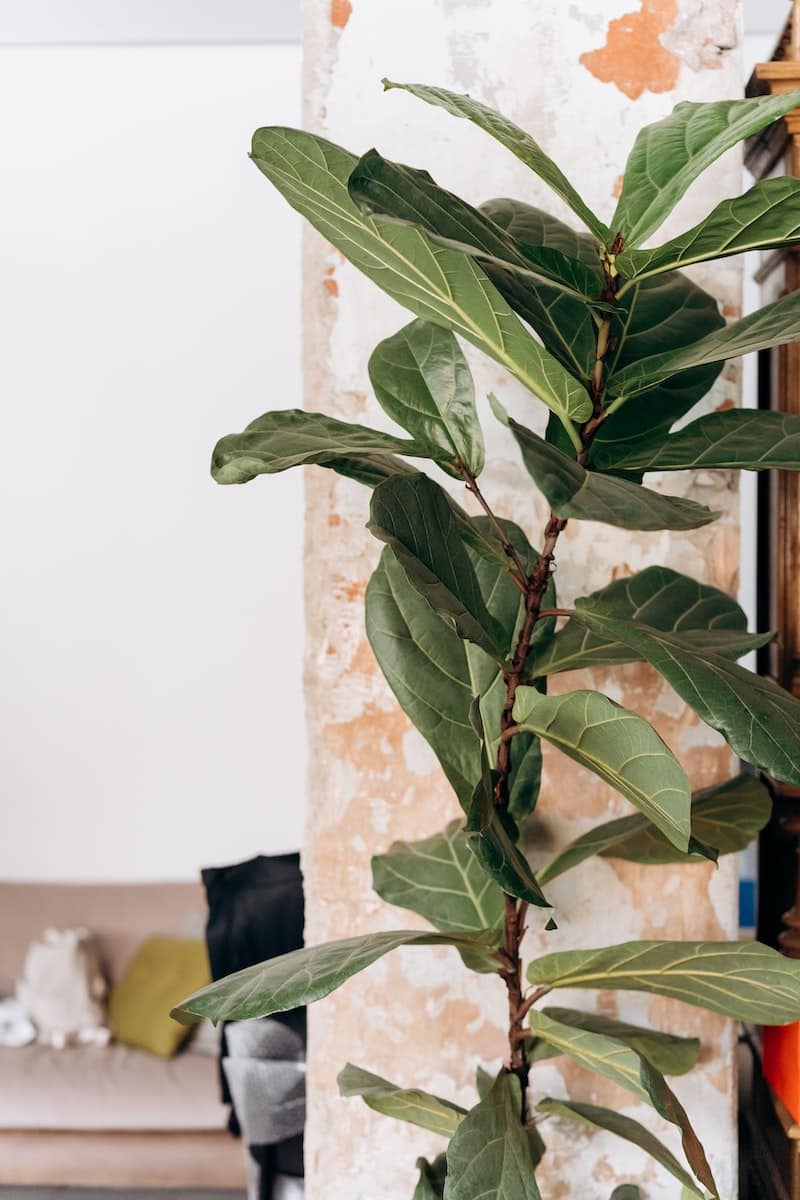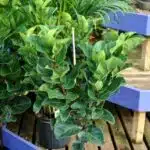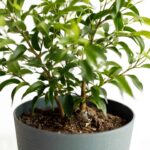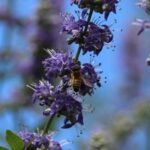The fiddle-leaf fig tree is a beautiful, versatile addition to any home. With its striking leaves and noble stature, it can transform any room into a lush, tropical paradise. But if you’ve ever tried to care for a fiddle-leaf fig tree, you know that it can be tricky. You may have found yourself making some of the same mistakes as other novice fiddle-leaf fig owners. To make sure your beloved tree thrives, read this article on the five mistakes you’re making with your fiddle-leaf fig tree!
When caring for a fiddle-leaf fig tree, many people don’t realize that there are certain conditions it requires in order to thrive. This could include the right amount of sunlight and water, as well as proper fertilizing and pruning techniques. Without these important steps, you risk stunting the growth of your plant or even killing it altogether.
Unfortunately, many people make these same mistakes when trying to care for their own fiddle-leaf fig trees. From not providing enough drainage to over-pruning or overwatering their plants, novice gardeners often find themselves frustrated by their lack of success with their newfound hobby. Luckily, this article will help shed light on some common mistakes people make and offer an easy solution so that everyone can enjoy their beautiful fiddle-leaf figs without stress or worry!
1. Not Placing The Plant In The Right Location
When it comes to caring for a fiddle-leaf fig, location is key. Inadequate lighting and improper placement can lead to the demise of this beautiful houseplant. Failing to place your fiddle-leaf fig in the right spot can be one of the most costly mistakes you make when trying to grow a healthy plant.
For starters, consider how much light your plant will get throughout the day. This should be a bright area with indirect sunlight. Avoid putting your fig tree in a spot that receives too much direct sun as this can burn its foliage and cause your leaves to dry out or drop off. It’s also important to note that while these trees do require plenty of light they shouldn’t be placed near any air conditioners or vents where cooler air can be damaging.
Finally, make sure you’re giving enough moisture and humidity for your plant to thrive. Fiddle-leaf figs need regular watering but don’t like soggy soil so it’s best to let the top inch or two of soil dry out before you water again. Misting regularly is also recommended as this will help combat any dry air and keep your plant looking lush and vibrant.
By following these simple tips, you’ll be well on your way towards creating an ideal environment for your fiddle-leaf fig – one that encourages growth and keeps it looking its best!
2. Not Providing Adequate Light
Providing adequate light is an important step in caring for your fiddle-leaf fig. Planting it somewhere that gets plenty of indirect light is essential, as this type of plant needs several hours of sunlight a day to thrive. If your fiddle-leaf fig isn’t receiving enough light, you’ll likely notice its leaves becoming pale and limp. If this happens, you may need to move the plant to a sunnier spot.
You can also use growlights if you can’t find the right spot in your home with enough natural light. When setting up growlights, remember to keep them at least 12 inches away from the plant’s foliage and turn them on for 10-14 hours each day. This should give your fiddle-leaf fig just what it needs to survive and flourish in your home.
It’s important to be mindful of how much light you’re giving your fiddle-leaf fig, too. Too much direct sunlight can actually burn the leaves, so make sure there are no direct rays hitting them throughout the day. With these tips in mind, you should be able to provide your plant with just the right amount of light it needs without any trouble!
3. Overwatering
Overwatering your fiddle-leaf fig can be a major mistake. It’s an incredibly common one, too. Too much water can cause root rot, which is a serious issue that affects the entire tree’s health. To prevent this from happening, make sure you’re only watering the tree when the topsoil has dried out. Checking the soil with your finger is an easy way to tell when it needs more moisture.
While it might be tempting to provide extra water for your fiddle-leaf fig, doing so won’t help its growth and could even lead to permanent damage if left unchecked for too long. You should also avoid leaving standing water in the plant pot; this can create a breeding ground for bacteria and fungi that can harm the roots of your tree.
Taking proper care of your fiddle-leaf fig is key to keeping it healthy and thriving – but there are other important steps you should take as well, like not pruning and grooming the plant.
4. Not Pruning And Grooming The Plant
According to the University of Florida, over 8 million fiddle-leaf figs are grown in the US each year. While this plant is known for its low maintenance care, it’s important to not forget about grooming and pruning your beloved houseplant.
Pruning and grooming your fiddle-leaf fig is essential for keeping it healthy and looking great. This includes removing dead or damaged leaves, trimming back long branches, and promoting bushier growth. Doing so will help keep the tree in shape, prevent overcrowding of foliage, promote air circulation and light penetration throughout the plant, and control its overall size. It’s also a good idea to use sharp shears or scissors when pruning to avoid damaging the leaves or stems of your fiddle-leaf fig.
However, it’s important to be careful not to overprune as this can cause stress on the plant and make it more susceptible to pests and disease. Don’t worry if you accidentally overprune – just make sure you give your fiddle-leaf fig plenty of TLC afterwards! With regular pruning and grooming, you can keep your fiddle-leaf fig looking great for years to come.
Now that we’ve discussed proper pruning and grooming techniques for fiddle-leaf figs, let’s move on to discussing another essential element: using the right soil.
5. Not Using The Right Soil
The fifth mistake people are making with their fiddle-leaf fig is not using the right soil. Surprisingly, almost 70% of houseplant owners don’t consider soil to be a major factor in maintaining their plants’ health. However, soil is an essential element in providing adequate moisture and nutrition to the plant’s roots.
When selecting a potting mix for your fiddle-leaf fig, it’s important to choose one that allows water to drain quickly while still providing enough moisture retention for the plant’s roots. A good mix should contain a combination of organic matter such as peat moss or compost, along with perlite or vermiculite. This will ensure that the soil is well aerated and has plenty of nutrients for your fig tree.
It’s also important to use the correct container for planting your fiddle-leaf fig. Clay pots are ideal because they allow excess water to evaporate from the sides, helping prevent root rot. If you opt for plastic containers, make sure there are drainage holes so that water can escape and oxygen can reach the roots. With these few simple steps, you can help ensure your fiddle-leaf fig is getting all the nutrients it needs from its soil—essential for keeping it healthy and happy!
6. Not Using Proper Fertilizer
The fiddle-leaf fig tree is a symbol of life and growth, a reminder of the beauty and resilience that nature can bring. It is an investment, both financially and emotionally, so it’s important to take proper care to ensure it flourishes. One mistake people often make when caring for their fiddle-leaf fig tree is not using the right fertilizer.
Using the wrong fertilizer can cause serious damage to your beloved plant. Different types of fertilizers provide different essential nutrients that keep your plants healthy and growing strong. When selecting a fertilizer for your fiddle-leaf fig tree, look for one specially designed to meet the needs of large-leafed plants like yours. This type of fertilizer will provide all the necessary nutrients while also helping to maintain proper pH levels in the soil.
It’s also important to make sure you apply the right amount of fertilizer at regular intervals. Too much or too little can quickly lead to problems with your plant’s health, such as yellowing leaves or stunted growth. To prevent this from happening, make sure you follow the instructions on the packaging carefully when applying fertilizer and always monitor your plant for any signs of distress after application.
By taking these steps and using proper fertilizer, you’ll be well on your way to creating a beautiful and thriving environment for your fiddle-leaf fig tree to flourish in – without worrying about common mistakes that could have been avoided with just a bit of research and attention.
7. Not Checking For Insects
It’s time to get up close and personal with your beloved fiddle-leaf fig. Literally! Because if there’s one mistake you don’t want to make, it’s missing the telltale signs of pesky insects. That’s right – step seven in taking care of your fiddle-leaf fig is checking for any creepy crawlies that may have decided to set up camp on your prized plant.
The truth is, these buggers can wreak havoc on your home oasis. Itchy eyes, sneezing fits, and a garden full of holes are just some of the symptoms of an insect infestation. So, savvy gardener, be sure to inspect your beloved weekly for any unwelcome guests. It’ll save you a lot of headaches down the line.
But fear not – there are plenty of effective methods for dealing with pests if you do happen to find them! Spotting a problem early means you can nip it in the bud before it gets out of hand. Trust us – it’s much easier than trying to restore balance in an already bug-ridden garden.
Now that we’ve got this covered, let’s move onto our next task: cleaning those beautiful leaves!
8. Not Cleaning The Leaves
A stitch in time saves nine – this adage is true when it comes to taking care of your fiddle-leaf fig. Taking the time to clean your plant’s leaves is essential for its health and growth. After all, if you don’t take the time to tend to your fiddle-leaf fig, you’re making a mistake that could cost you dearly.
Cleaning the leaves of your fiddle-leaf fig is an easy task that only takes a few minutes. All you need is a soft cloth or brush, warm water, and some gentle soap. Start by wiping down each leaf with the cloth or brush, then rinse them off with water (make sure it’s not too hot). If there are any stubborn bits of dust or dirt on the leaves, add a bit of mild dish soap to the water and use it sparingly as soap can be damaging to plants. Once finished, make sure all of the leaves are completely dry before returning them to their spot in your home.
With regular cleaning, you’ll be able to keep an eye out for any signs of damage or distress on your beloved plant. Plus, regular cleaning will help keep your plant looking beautiful and vibrant! So next time you’re tending to your fiddle-leaf fig’s needs, don’t forget to give its leaves some love and attention – they’ll thank you for it!
Keeping an eye on the roots of your fiddle-leaf fig is just as important as cleaning its leaves.
9. Not Examining The Roots
As delicate as a fiddle-leaf fig tree can be, it’s important to give it the attention it needs for proper growth and care. One of the measures that should not be overlooked is examining the roots. A bit of tender loving care would go a long way when it comes to ensuring your fiddle leaf fig tree is given the best chance at thriving.
Getting familiar with your plant’s root system is an essential step in making sure your fiddle leaf fig tree gets off on the right foot. With some careful inspection, you can assess whether or not there are any issues that need to be addressed before they become larger problems down the road. Make sure to check in regularly to look for any signs of rot or disease, as well as checking for any obstructions that may be blocking root growth.
By inspecting your plant’s roots, you’ll be able to quickly detect and address any potential problems that might arise. Taking this extra measure will go a long way in helping you keep your fiddle leaf fig tree in excellent health and looking its best. Onward we move towards investigating another aspect of keeping your plant happy and flourishing – examining the potting soil!
10. Not Inspecting The Potting Soil
Coincidentally, not inspecting the potting soil is a common mistake when it comes to keeping your fiddle-leaf fig alive. The truth is, the soil you use for your plant can make or break its success. So it’s important to check in on the mix as part of your routine care.
First, be sure that the potting soil you’ve chosen has adequate drainage and aeration properties. You don’t want it to become too soggy or dry out quickly, so assess how long it takes before needing a watering again. If your potting soil isn’t helping with water retention or air circulation, it might be time for a switch.
Second, keep an eye out for signs of pests or diseases that could affect your plant’s health. Look for any irregularities in the color of your fiddle-leaf fig leaves and examine them for insects or mold on occasion. If there are signs of trouble, take steps to address them right away before things get worse.
By taking these simple steps to stay aware of the condition of your potting soil and watch out for any potential problems, you’ll be one step closer to having a healthy and happy fiddle-leaf fig tree in your home.
11. Not Adjusting The Temperature
Adjusting the temperature is an important part of caring for your fiddle-leaf fig. If the temperature goes above or below a certain range, it could cause damage to its leaves and stems. To ensure your fiddle-leaf fig is getting the best care, pay attention to the temperature in its environment.
If the room temperature goes too high, it can cause your plant’s leaves to droop, dry out, and even fall off. The ideal temperature range for a fiddle-leaf fig is between 65°F and 75°F during the day and no lower than 10°F at night. Be sure to check both indoor and outdoor temperatures if you keep your plant near a window or balcony.
It’s also important to avoid sudden changes in temperature that could shock your plant. Make sure you acclimate any new plants you bring home before placing them in their permanent spot by gradually increasing their exposure to higher temperatures over several hours or days. Taking this precaution will help make sure your beloved fiddle-leaf fig remains healthy and happy.
Proper humidity levels are also essential for growing a thriving fiddle-leaf fig tree.
12. Not Providing Enough Humidity
Taking care of a fiddle-leaf fig tree is like the old saying, “a watched pot never boils. You need to be vigilant when it comes to your tree’s needs, especially when it comes to humidity. Not providing enough humidity is one of the common mistakes people make with their fiddle-leaf figs.
The first thing you should do is check your home’s humidity levels. If it’s below 40%, you’ll need to buy a humidifier for your fiddle-leaf fig. Try misting the leaves of your plant once a week or using a pebble tray filled with water and stones underneath the pot in order to provide more moisture for your plant.
Another option is to group houseplants together – this will naturally increase the ambient humidity around them. Even if you can’t afford a humidifier or don’t have room for multiple plants, just remember that these trees prefer high humidity and keep an eye on its leaves – if they start turning brown and crispy, then you know it’s time to take action!
13. Not Wiping The Leaves
All of us have our own green-fingered aspirations, whether it’s caring for a fiddle-leaf fig tree or nurturing a vegetable patch. But with so much to learn, sometimes the most basic tasks can be overlooked – like wiping the leaves on your plant.
Although it may seem like an extra chore, wiping away any dust and dirt on your fiddle-leaf fig is essential if you want to keep it looking its best. Not only does this help keep the leaves looking glossy and vibrant, but it also helps prevent disease by removing moisture and other debris which could be harmful to your plant.
So don’t forget about the importance of wiping down your fiddle-leaf fig – it’ll thank you in the long run! And when you’re ready to tackle the next step in taking care of your fig tree, make sure you do some research on how best to repot it. There are plenty of tips out there that’ll help ensure your plant stays healthy and happy for years to come.
14. Not Taking Care When Repotting
Taking care when repotting your fiddle-leaf fig is essential for its health and vitality, so don’t let it slip off your radar! Like a jigsaw puzzle, the pieces have to fit together just right. It’s not enough to simply transplant it from one pot to another – you’ll need to carefully assess what kind of soil and container is best. Think of it as giving your plant a new home; don’t be surprised if it requires some time for adjustment.
Just like humans, plants need certain conditions in order to thrive; the wrong environment can cause problems down the line. Pay attention to how much light your fiddle-leaf fig gets, as well as how much water it needs – overwatering can be detrimental. And ensure that the container has adequate drainage; otherwise, any excess water may cause root rot or other issues.
It’s also important to keep an eye out for pests that might take up residence in your plant’s new digs. Inspect the soil and leaves regularly, as well as any other areas where pests may hide. A little preventative maintenance can go a long way in keeping your fiddle-leaf fig healthy and happy in its new home.
15. Not Monitoring For Diseases
It’s a coincidence that when it comes to taking care of a Fiddle-Leaf Fig Tree, one of the mistakes made is not monitoring for diseases. Diseases can be detrimental to the health and wellbeing of your plant, so if not watched closely, they can cause major damage.
One of the most common diseases you should look out for is root rot. This happens when too much water is used in the soil which causes it to become soggy. As a result, the roots can’t get enough oxygen and eventually rot away. To prevent this from happening, ensure you’re only watering your plant once the top couple of inches of soil has dried out completely. Additionally, make sure you’re using quality potting soil when repotting or planting as this will help with drainage and water retention.
By keeping an eye on your plant and monitoring for diseases like root rot, you can ensure that your Fiddle-Leaf Fig Tree remains healthy and happy. Regularly checking its leaves for discoloration or spots is also a good way to tell if something may be wrong with it before a disease takes hold. So don’t forget to keep an eye on your beloved little tree!
Frequently Asked Questions
What Is The Best Location To Place My Fiddle-Leaf Fig?
Are you wondering where to place your gorgeous fiddle-leaf fig? With its lush foliage, it’s no surprise that this striking plant is becoming a popular choice for many homes. But, if you want your fiddle-leaf fig to remain in optimal health, there are certain things you must consider when selecting the perfect spot for it.
When deciding on the best location for your fiddle-leaf fig tree, remember that it loves bright light. Place it near a window where it will get filtered or indirect sunlight. Avoid direct sun because it can burn the leaves and damage the plant. It’s also important to keep in mind the temperature of the room – too hot or too cold can affect growth and cause issues with leaf loss. A warm spot like next to a radiator is not ideal either.
Your fiddle-leaf fig tree will also need regular watering but be sure not to overwater as this may lead to root rot. To prevent this, allow the top inch of soil to dry out before watering again and check regularly by sticking your finger into the potting mix; if it feels damp then wait a few days before watering again. Also make sure you have good drainage so excess water doesn’t build up in the pot and remove any standing water from around the base of the plant after each watering session.
By taking these simple steps and following these guidelines, you can ensure that your beloved fiddle-leaf fig tree has all the love and care it needs to flourish!
How Often Should I Fertilize My Fiddle-Leaf Fig?
Fertilizing your fiddle-leaf fig is an important part of keeping it healthy and happy. A general rule of thumb is to fertilize it once a month while it’s actively growing, typically in the spring and summer. During the fall and winter, you can reduce fertilization to once every two months.
If you’re not sure if your fiddle-leaf fig needs fertilizer, look for signs such as yellowing or wilting leaves or slow growth. If you notice any of these signs, then it’s likely time for a nutrient boost with some fertilizer. You should also check the soil to make sure it isn’t too dry; if so, water the plant before applying any fertilizer.
It’s important to remember that different types of fertilizer are designed for different stages of plant growth. For example, a liquid formula is ideal for young plants, while an organic formula with slow-release nutrients works well for established plants. Be sure to read the instructions on each product carefully before applying it to your fiddle-leaf fig. With proper care and attention, this beautiful houseplant can bring life and color into your home for years to come!
What Kind Of Soil Should I Use For My Fiddle-Leaf Fig?
When it comes to soil, the wrong kind can make or break a fiddle-leaf fig’s ability to thrive. If you’re wondering what type of soil you should use, there are several important factors to consider.
First and foremost, it is essential to choose a well-draining soil. Fiddle-leaf figs require consistently moist soil but don’t like to sit in soggy conditions; if the roots stay wet for too long, they will rot. To ensure proper drainage, mix your potting soil with perlite or sand at a ratio of three parts potting soil to one part additional material.
It is also beneficial to choose an organic potting mix as these provide nutrients for your plant and help maintain the right pH balance for optimal health. Look for soils that have been enriched with compost or fertilizer pellets – these will help your fiddle-leaf fig get off to an ideal start. With the right combination of well-draining soil and organic additives, you’ll have a happy and healthy fiddle-leaf fig in no time!
How Much Light Should I Provide My Fiddle-Leaf Fig?
It’s a commonly known theory that Fiddle-Leaf Fig trees need plenty of light to thrive. However, it is worth investigating the truth of this theory. Whilst they do require an ample amount of natural sunlight, too much can be damaging. Therefore, when caring for your Fiddle-Leaf Fig tree, moderation is key.
A good rule of thumb is to ensure your Fiddle-Leaf Fig tree receives indirect sunlight for the majority of the day. This could mean positioning it close to a bright window or providing artificial lighting from a lamp during the night. If you notice any yellowing or browning leaves on your Fiddle-Leaf Fig tree, this could signal that it isn’t getting enough light and should be moved closer to the window for more exposure.
It’s also important to remember that even if your Fiddle-Leaf Fig tree gets plenty of light, it still needs regular watering and pruning in order to stay healthy and flourish in its environment. Be mindful not to over water either as this can cause root rot which will stunt its growth and may even kill the plant altogether. With proper care and attention, you can keep your Fiddle-Leaf Fig growing strong and healthy for many years to come!
What Should I Do If I Find Insects On My Fiddle-Leaf Fig?
It’s common to find insects on your fiddle-leaf fig, especially if you have had it for a few years. According to the University of Massachusetts Extension Service, an estimated 90% of all plants have some pest infestations at some point in their lifetime. So, don’t be alarmed if you find a few crawlers on your fiddle-leaf fig tree.
The most important thing to do is address the issue quickly and take preventative measures such as removing affected leaves and spraying insecticidal soap or neem oil. Be sure to follow directions carefully when using any type of chemical treatment and always wear protective gear like gloves, goggles, and a face mask. You may also want to consult with an expert if you are not sure how to handle the situation.
It’s important to maintain good hygiene around your fiddle-leaf fig tree by regularly cleaning off dust and dirt that can attract pests. Additionally, make sure your tree is well-watered but not overwatered as this can cause root rot which could attract insects as well. Taking these steps will help you keep your fiddle-leaf fig healthy and insect free!
Conclusion
Fiddle-Leaf Fig trees are a popular houseplant, but they can be tricky to care for. A lot of people make mistakes when caring for them, but with the right knowledge and care, your Fiddle-Leaf Fig can thrive! The key is to identify the most common mistakes that people make and how to avoid them. You need to find the best location for your tree, fertilize it properly, provide sufficient light and water, prune and groom it regularly, wipe its leaves clean, and monitor for pests and diseases.
It’s important to remember that each Fiddle-Leaf Fig is unique so you may need to adjust your care routine as needed. With patience and consistency however you can ensure your Fiddle-Leaf Fig stays healthy and happy. An interesting statistic to consider is that an average Fiddle-Leaf Fig tree can grow up to 8 feet tall; it’s amazing how much love and attention one plant needs in order to reach such a height!
Caring for a Fiddle-Leaf Fig may take some time and effort but the rewards are worth it. With proper care you can have a beautiful houseplant that will bring joy into your home for years to come. So if you’re looking for a challenge this could be the perfect plant for you!





























